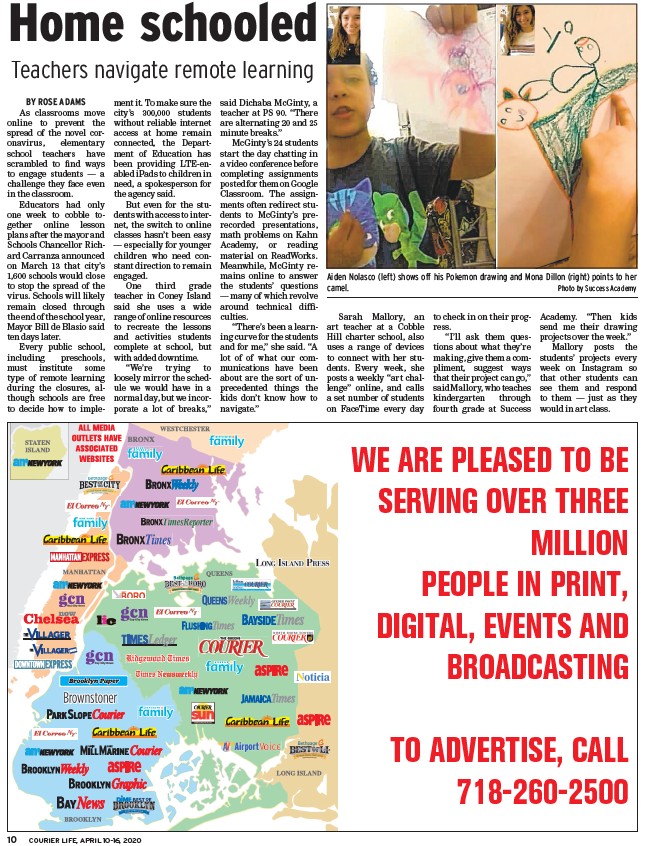
Home schooled
BY ROSE ADAMS
As classrooms move
online to prevent the
spread of the novel coronavirus,
elementary
school teachers have
scrambled to fi nd ways
to engage students — a
challenge they face even
in the classroom.
Educators had only
one week to cobble together
online lesson
plans after the mayor and
Schools Chancellor Richard
Carranza announced
on March 13 that city’s
1,600 schools would close
to stop the spread of the
virus. Schools will likely
remain closed through
the end of the school year,
Mayor Bill de Blasio said
ten days later.
Every public school,
including preschools,
must institute some
type of remote learning
during the closures, although
schools are free
to decide how to implement
it. To make sure the
city’s 300,000 students
without reliable internet
access at home remain
connected, the Department
of Education has
been providing LTE-enabled
iPads to children in
need, a spokesperson for
the agency said.
But even for the students
with access to internet,
the switch to online
classes hasn’t been easy
— especially for younger
children who need constant
direction to remain
engaged.
One third grade
teacher in Coney Island
said she uses a wide
range of online resources
to recreate the lessons
and activities students
complete at school, but
with added downtime.
“We’re trying to
loosely mirror the schedule
we would have in a
normal day, but we incorporate
COURIER L 10 IFE, APRIL 10-16, 2020
a lot of breaks,”
said Dichaba McGinty, a
teacher at PS 90. “There
are alternating 20 and 25
minute breaks.”
McGinty’s 24 students
start the day chatting in
a video conference before
completing assignments
posted for them on Google
Classroom. The assignments
often redirect students
to McGinty’s prerecorded
presentations,
math problems on Kahn
Academy, or reading
material on ReadWorks.
Meanwhile, McGinty remains
online to answer
the students’ questions
— many of which revolve
around technical diffi -
culties.
“There’s been a learning
curve for the students
and for me,” she said. “A
lot of of what our communications
have been
about are the sort of unprecedented
things the
kids don’t know how to
navigate.”
Aiden Nolasco (left) shows off his Pokemon drawing and Mona Dillon (right) points to her
camel. Photo by Success Academy
Sarah Mallory, an
art teacher at a Cobble
Hill charter school, also
uses a range of devices
to connect with her students.
Every week, she
posts a weekly “art challenge”
online, and calls
a set number of students
on FaceTime every day
to check in on their progress.
“I’ll ask them questions
about what they’re
making, give them a compliment,
suggest ways
that their project can go,”
said Mallory, who teaches
kindergarten through
fourth grade at Success
Academy. “Then kids
send me their drawing
projects over the week.”
Mallory posts the
students’ projects every
week on Instagram so
that other students can
see them and respond
to them — just as they
would in art class.
Teachers navigate remote learning
WE ARE PLEASED TO BE
SERVING OVER THREE
MILLION
PEOPLE IN PRINT,
DIGITAL, EVENTS AND
BROADCASTING
TO ADVERTISE, CALL
718-260-2500